
A | B | C | D | E | F | G | H | CH | I | J | K | L | M | N | O | P | Q | R | S | T | U | V | W | X | Y | Z | 0 | 1 | 2 | 3 | 4 | 5 | 6 | 7 | 8 | 9
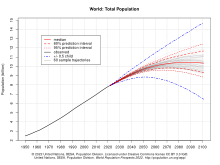
In world demographics, the world population is the total number of humans currently living. It was estimated by the United Nations to have exceeded eight billion in mid-November 2022. It took around 300,000 years of human prehistory and history for the human population to reach a billion and only 222 years more to reach 8 billion.[2]
The human population has experienced continuous growth following the Great Famine of 1315–1317 and the end of the Black Death in 1350, when it was nearly 370,000,000.[3] The highest global population growth rates, with increases of over 1.8% per year, occurred between 1955 and 1975, peaking at 2.1% between 1965 and 1970.[4] The growth rate declined to 1.1% between 2015 and 2020 and is projected to decline further in the 21st century.[5] The global population is still increasing, but there is significant uncertainty about its long-term trajectory due to changing fertility and mortality rates.[6] The UN Department of Economics and Social Affairs projects between 9 and 10 billion people by 2050 and gives an 80% confidence interval of 10–12 billion by the end of the 21st century,[1] with a growth rate by then of zero. Other demographers predict that the human population will begin to decline in the second half of the 21st century.[7]
The total number of births globally is currently (2015–2020) 140 million/year, which is projected to peak during the period 2040–2045 at 141 million/year and then decline slowly to 126 million/year by 2100.[8] The total number of deaths is currently 57 million/year and is projected to grow steadily to 121 million/year by 2100.[9]
The median age of human beings as of 2020[update] is 31 years.[10]
History

Estimates of world population by their nature are an aspect of modernity, possible only since the Age of Discovery. Early estimates for the population of the world[11] date to the 17th century: William Petty, in 1682, estimated the world population at 320 million (current estimates ranging close to twice this number); by the late 18th century, estimates ranged close to one billion (consistent with current estimates).[12] More refined estimates, broken down by continents, were published in the first half of the 19th century, at 600 million to 1 billion in the early 1800s and 800 million to 1 billion in the 1840s.[13]
It is difficult for estimates to be better than rough approximations, as even current population estimates are fraught with uncertainties from 3% to 5%.[14]
Ancient and post-classical history
Estimates of the population of the world at the time agriculture emerged in around 10,000 BC have ranged between 1 million and 15 million.[15][16] Even earlier, genetic evidence suggests humans may have gone through a population bottleneck of between 1,000 and 10,000 people about 70,000 BC, according to the now largely discredited Toba catastrophe theory. By contrast, it is estimated that around 50–60 million people lived in the combined eastern and western Roman Empire in the 4th century AD.[17]
The Plague of Justinian caused Europe's population to drop by around 50% between the 6th and 8th centuries AD.[18] The population of Europe was more than 70 million in 1340.[19] From 1340 to 1400, the world's population fell from an estimated 443 million to 350–375 million,[20] with the Indian subcontinent suffering the most tremendous loss and Europe suffering the Black Death pandemic;[21] it took 200 years for European population figures to recover.[22] The population of China decreased from 123 million in 1200 to 65 million in 1393,[23] presumably from a combination of Mongol invasions, famine, and plague.[24]
Starting in AD 2, the Han dynasty of ancient China kept consistent family registers to properly assess the poll taxes and labor service duties of each household.[25] In that year, the population of Western Han was recorded as 57,671,400 individuals in 12,366,470 households, decreasing to 47,566,772 individuals in 9,348,227 households by AD 146, towards the end of the Han dynasty.[25] From 200 to 400, the world population fell from an estimated 257 million to 206 million, with China suffering the greatest loss.[21] At the founding of the Ming dynasty in 1368, China's population was reported to be close to 60 million; toward the end of the dynasty in 1644, it may have approached 150 million.[26] England's population reached an estimated 5.6 million in 1650, up from an estimated 2.6 million in 1500.[27] New crops that were brought to Asia and Europe from the Americas by Portuguese and Spanish colonists in the 16th century are believed to have contributed to population growth.[28][29][30] Since their introduction to Africa by Portuguese traders in the 16th century,[31] maize and cassava have similarly replaced traditional African crops as the most important staple food crops grown on the continent.[32]
The pre-Columbian population of the Americas is uncertain; historian David Henige called it "the most unanswerable question in the world."[33] By the end of the 20th century, scholarly consensus favored an estimate of roughly 55 million people, but numbers from various sources have ranged from 10 million to 100 million.[34] Encounters between European explorers and populations in the rest of the world often introduced local epidemics of extraordinary virulence.[35] According to the most extreme scholarly claims, as many as 90% of the Native American population of the New World died of Old World diseases such as smallpox, measles, and influenza.[36] Over the centuries, the Europeans had developed high degrees of immunity to these diseases, while the indigenous peoples had no such immunity.[37]
Modern history
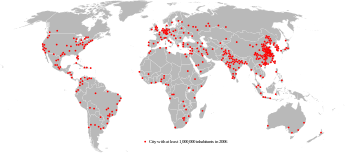
During the European Agricultural and Industrial Revolutions, the life expectancy of children increased dramatically.[40] The percentage of the children born in London who died before the age of five decreased from 74.5% in 1730–1749 to 31.8% in 1810–1829.[41][42] Between 1700 and 1900, Europe's population increased from about 100 million to over 400 million.[43] Altogether, the areas populated by people of European descent comprised 36% of the world's population in 1900.[44]
Population growth in the Western world became more rapid after the introduction of vaccination and other improvements in medicine and sanitation.[45] Improved material conditions led to the population of Britain increasing from 10 million to 40 million in the 19th century.[46] The population of the United Kingdom reached 60 million in 2006.[47] The United States saw its population grow from around 5.3 million in 1800 to 106 million in 1920, exceeding 307 million in 2010.[48]
The first half of the 20th century in Imperial Russia and the Soviet Union was marked by a succession of major wars, famines and other disasters which caused large-scale population losses (approximately 60 million excess deaths).[49][50] After the collapse of the Soviet Union, Russia's population declined significantly – from 150 million in 1991 to 143 million in 2012[51] – but by 2013 this decline appeared to have halted.[52]
Many countries in the developing world have experienced extremely rapid population growth since the early 20th century, due to economic development and improvements in public health. China's population rose from approximately 430 million in 1850 to 580 million in 1953,[53] and now stands at over 1.3 billion. The population of the Indian subcontinent, which was about 125 million in 1750, increased to 389 million in 1941;[54] today, India, Pakistan and Bangladesh are collectively home to about 1.63 billion people.[55] Java, an island in Indonesia, had about 5 million inhabitants in 1815; it had a population of over 139 million in 2020.[56] In just one hundred years, the population of Brazil decupled (x10), from about 17 million in 1900, or about 1% of the world population in that year, to about 176 million in 2000, or almost 3% of the global population in the very early 21st century. Mexico's population grew from 13.6 million in 1900 to about 112 million in 2010.[57][58] Between the 1920s and 2000s, Kenya's population grew from 2.9 million to 37 million.[59]
Milestones by the billions
| Population | 1 | 2 | 3 | 4 | 5 | 6 | 7 | 8 | 9 | 10 |
|---|---|---|---|---|---|---|---|---|---|---|
| Year | 1804 | 1927 | 1960 | 1974 | 1987 | 1999 | 2011 | 2022 | 2037 | 2057 |
| Years elapsed | 200,000+ | 123 | 33 | 14 | 13 | 12 | 12 | 11 | 15 | 20 |
The UN estimated that the world population reached one billion for the first time in 1804. It was another 123 years before it reached two billion in 1927, but it took only 33 years to reach three billion in 1960.[61] Thereafter, it took 14 years for the global population to reach four billion in 1974, 13 years to reach five billion in 1987, 12 years to reach six billion in 1999 and, according to the United States Census Bureau, 13 years to reach seven billion in March 2012.[62] The United Nations, however, estimated that the world population reached seven billion in October 2011.[63][64][65]
According to the UN, the global population reached eight billion in November 2022,[66] but because the growth rate is slowing, it will take another 15 years to reach around 9 billion by 2037 and 20 years to reach 10 billion by 2057.[67] Alternative scenarios for 2050 range from a low of 7.4 billion to a high of more than 10.6 billion.[68] Projected figures vary depending on underlying statistical assumptions and the variables used in projection calculations, especially the fertility and mortality variables. Long-range predictions to 2150 range from a population decline to 3.2 billion in the "low scenario", to "high scenarios" of 24.8 billion.[68] One extreme scenario predicted a massive increase to 256 billion by 2150, assuming the global fertility rate remained at its 1995 level of 3.04 children per woman; however, by 2010 the global fertility rate had declined to 2.52.[69][70]
There is no estimation for the exact day or month the world's population surpassed one or two billion. The points at which it reached three and four billion were not officially noted, but the International Database of the United States Census Bureau placed them in July 1959 and April 1974 respectively. The United Nations did determine, and commemorate, the "Day of 5 Billion" on 11 July 1987, and the "Day of 6 Billion" on 12 October 1999. The Population Division of the United Nations declared the "Day of Seven Billion" to be 31 October 2011.[71] The United Nations marked the birth of the eight billionth person on 15 November 2022.[72][66]
Global demographics

- >80
- 77.5–80
- 75–77.5
- 72.5–75
- 70–72.5
- 67.5–70
- 65–67.5
- 60–65
- 55–60
- 50–55
As of 2020, the global sex ratio is approximately 1.01 males to 1 female.[74] Approximately 24.7% of the global population is aged under 15, while 65.2% is aged 15–64 and 10.1% is aged 65 or over.[74] The median age of the world's population is estimated to be 31 years in 2020,[10] and is expected to rise to 37.9 years by 2050.[75]
According to the World Health Organization, the global average life expectancy is 73.3 years as of 2020, with women living an average of 75.9 years and men approximately 70.8 years.[76] In 2010, the global fertility rate was estimated at 2.44 children per woman.[77] In June 2012, British researchers calculated the total weight of Earth's human population as approximately 287 million tonnes (630 billion pounds), with the average person weighing around 62 kilograms (137 lb).[78]
The IMF estimated nominal 2021 gross world product at US$94.94 trillion, giving an annual global per capita figure of around US$12,290.[79] Around 9.3% of the world population live in extreme poverty, subsisting on less than US$1.9 per day;[80] around 8.9% are malnourished.[81] 87% of the world's over-15s are considered literate.[82] As of January 2024, there were about 5 billion global Internet users, constituting 66% of the world population.[83]
The Han Chinese are the world's largest single ethnic group, constituting over 19% of the global population in 2011.[84] The world's most-spoken languages[a] are English (1.132B), Mandarin Chinese (1.117B), Hindi (615M), Spanish (534M) and French (280M). More than three billion people speak an Indo-European language, which is the largest language family by number of speakers. Standard Arabic is a language with no native speakers, but the total number of speakers is estimated at 274 million people.[85]
The largest religious categories in the world as of 2020 are estimated as follows: Christianity (31%), Islam (25%), Unaffiliated (16%) and Hinduism (15%).[86]
Population by region
Six of the Earth's seven continents are permanently inhabited on a large scale. Asia is the most populous continent, with its 4.64 billion inhabitants accounting for 60% of the world population. The world's two most populated countries, India and China, together constitute about 36% of the world's population. Africa is the second most populated continent, with around 1.34 billion people, or 17% of the world's population. Europe's 747 million people make up 10% of the world's population as of 2020, while the Latin American and Caribbean regions are home to around 653 million (8%). Northern America, primarily consisting of the United States and Canada, has a population of around 368 million (5%), and Oceania, the least populated region, has about 42 million inhabitants (0.5%).[87] Antarctica only has a very small, fluctuating population of about 1200 people based mainly in polar science stations.[88]
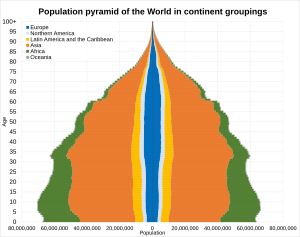
| Region | 2022 (percent) | 2030 (percent) | 2050 (percent) |
|---|---|---|---|
| Sub-Saharan Africa | 1,152 (14.51%) | 1,401 (16.46%) | 2,094 (21.62%) |
| Northern Africa and Western Asia | 549 (6.91%) | 617 (7.25%) | 771 (7.96%) |
| Central Asia and Southern Asia | 2,075 (26.13%) | 2,248 (26.41%) | 2,575 (26.58%) |
| Eastern Asia and Southeastern Asia | 2,342 (29.49%) | 2,372 (27.87%) | 2,317 (23.92%) |
| Europe and Northern America | 1,120 (14.10%) | 1,129 (13.26%) | 1,125 (11.61%) |
| Latin America and the Caribbean | 658 (8.29%) | 695 (8.17%) | 749 (7.73%) |
| Australia and New Zealand | 31 (0.39%) | 34 (0.40%) | 38 (0.39%) |
| Oceania | 14 (0.18%) | 15 (0.18%) | 20 (0.21%) |
| World | 7,942 | 8,512 | 9,687 |
Graphs are unavailable due to technical issues. There is more info on Phabricator and on MediaWiki.org. |
| Region | Density (inhabitants/km2) |
Population (millions) |
Most populous country | Most populous city (metropolitan area) |
|---|---|---|---|---|
| Asia | 104.1 | 4,641 | 1,439,090,595 – |
13,515,000 – (37,400,000 – |
| Africa | 44.4 | 1,340 | 211,401,000 – |
9,500,000 – (20,076,000 – |
| Europe | 73.4 | 747 | 146,171,000 – |
13,200,000 – (20,004,000 – |
| Latin America | 24.1 | 653 | 214,103,000 – |
12,252,000 – (21,650,000 – |
| Northern America[note 1] | 14.9 | 368 | 332,909,000 – |
8,804,000 – (23,582,649 – |
| Oceania | 5 | 42 | 25,917,000 – |
5,367,000 – |
| Antarctica | ~0 | 0.004[88] | N/A[note 2] | 1,258 – |
Largest populations by country
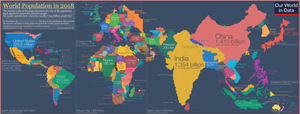

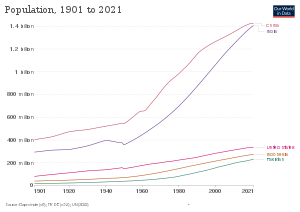
Ten most populous countries
| Country / Dependency | Population | % of world |
Date | Source (official or from the United Nations) |
|---|---|---|---|---|
| 1,425,775,850 | 17.6% | 14 Apr 2023 | UN projection[91] | |
| 1,409,670,000 | 17.4% | 17 Jan 2024 | National annual estimate[92] | |
| 336,475,120 | 4.15% | 24 May 2024 | National population clock[93] | |
| 278,696,200 | 3.44% | 1 Jul 2023 | National annual estimate[94] | |
| 229,488,994 | 2.83% | 1 Jul 2022 | UN projection[95] | |
| 216,746,934 | 2.67% | 1 Jul 2022 | UN projection[95] | |
| 217,696,701 | 2.68% | 24 May 2024 | National population clock[96] | |
| 168,220,000 | 2.07% | 1 Jul 2020 | Annual Population Estimate[97] | |
| 147,190,000 | 1.82% | 1 Oct 2021 | 2021 preliminary census results[98] | |
| 128,271,248 | 1.58% | 31 Mar 2022 |
Approximately 4.6 billion people live in these ten countries, representing around 57% of the world's population as of July 2023.
The UN estimates that by 2023 India will have overtaken China in having the largest population.[99][91]
| # | Most populous countries | 2000 | 2015 | 2030[A] |
| ||
|---|---|---|---|---|---|---|---|
| 1 | 1,270 | 1,376 | 1,416 | ||||
| 2 | 1,053 | 1,311 | 1,528 | ||||
| 3 | 283 | 322 | 356 | ||||
| 4 | 212 | 258 | 295 | ||||
| 5 | 136 | 208 | 245 | ||||
| 6 | 176 | 206 | 228 | ||||
| 7 | 123 | 182 | 263 | ||||
| 8 | 131 | 161 | 186 | ||||
| 9 | 146 | 146 | 149 | ||||
| 10 | 103 | 127 | 148 | ||||
| World total | 6,127 | 7,349 | 8,501 | ||||
| Notes: | |||||||
Most densely populated countries
The tables below list the world's most densely populated countries, both in absolute terms and in comparison to their total populations, as of November 2022. All areas and populations are from The World Factbook, unless otherwise noted.
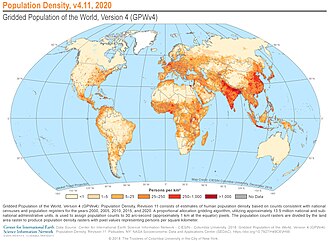
| Rank | Country | Population | Area (km2) |
Density (pop/km2) |
|---|---|---|---|---|
| 1 | 5,921,231 | 719 | 8,235 | |
| 2 | 165,650,475 | 148,460 | 1,116 | |
| 3 | 5,223,000 | 6,025 | 867 | |
| 4 | 23,580,712 | 35,980 | 655 | |
| 5 | 51,844,834 | 99,720 | 520 | |
| 6 | 5,296,814 | 10,400 | 509 | |
| 7 | 13,173,730 | 26,338 | 500 | |
| 8 | 12,696,478 | 27,830 | 456 | |
| 9 | 1,389,637,446 | 3,287,263 | 423 | |
| 10 | 17,400,824 | 41,543 | 419 |
| Rank | Country | Population | Area (km2) |
Density (pop/km2) |
Population trend[citation needed] |
|---|---|---|---|---|---|
| 1 | 1,389,637,446 | 3,287,263 | 423 | Growing
Zdroj:https://en.wikipedia.org?pojem=Global_population Text je dostupný za podmienok Creative Commons Attribution/Share-Alike License 3.0 Unported; prípadne za ďalších podmienok. Podrobnejšie informácie nájdete na stránke Podmienky použitia.
Analytika
Antropológia Aplikované vedy Bibliometria Dejiny vedy Encyklopédie Filozofia vedy Forenzné vedy Humanitné vedy Knižničná veda Kryogenika Kryptológia Kulturológia Literárna veda Medzidisciplinárne oblasti Metódy kvantitatívnej analýzy Metavedy Metodika Text je dostupný za podmienok Creative
Commons Attribution/Share-Alike License 3.0 Unported; prípadne za ďalších
podmienok. www.astronomia.sk | www.biologia.sk | www.botanika.sk | www.dejiny.sk | www.economy.sk | www.elektrotechnika.sk | www.estetika.sk | www.farmakologia.sk | www.filozofia.sk | Fyzika | www.futurologia.sk | www.genetika.sk | www.chemia.sk | www.lingvistika.sk | www.politologia.sk | www.psychologia.sk | www.sexuologia.sk | www.sociologia.sk | www.veda.sk I www.zoologia.sk |
